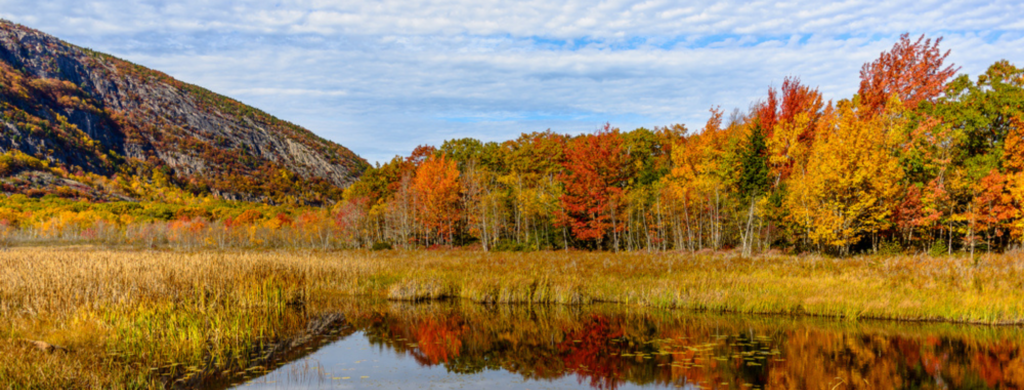DESTINATION: Joshua Tree National Park
Joshua Tree National Park hosts an amazing array of terrain, plants and wildlife. Its intriguing Joshua Trees and huge boulders are as warmly inviting as the mild temperatures. No matter what kind of traveler you are, this national park should be high on your bucket list.
The park has a variety of amazing desert features as well, from the course-grained Monzogranite boulders to the plump Chuckwalla. But of course, the real stars of the show are the eponymous Joshua trees.
Head's up: pets are not permitted on any trails in the park with the exception of the paved Mara Trail. If you have any questions, seek one of the rangers on duty.
Here are five amazing things to see and do at Joshua Tree National Park:
1. The Joshua Trees and Desert Flower Viewing
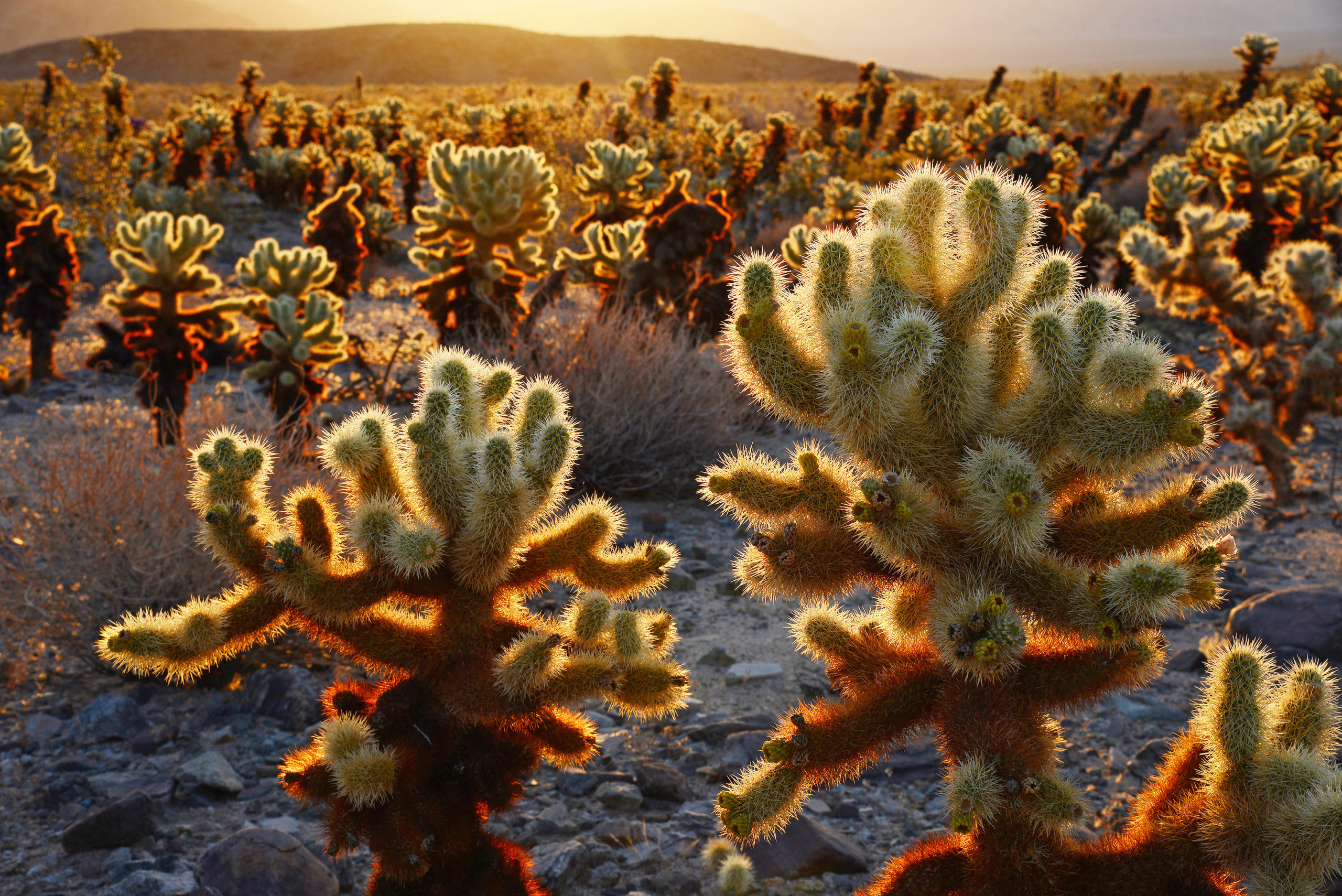
Photo: Shutterstock
In February, the desert awakens from its winter nap and starts to show some vivid color. Along the southern park boundary and into the lower elevations of the Pinto Basin, you'll notice smaller flowers emerge. By March and April, in the higher elevations, bright blooms emerge almost overnight. Even as late as June, the bloom continues up into elevations above 5000 feet.
Spring temperatures and precipitation levels during the fall and winter months dictate whether it will be to be a "good" year to view the desert bloom. From September to December, the desert annuals germinate and they need an ample soaking rain to begin growing. Of course, the plants require warmer temps for the stalks to grow. That's why you may see green ground cover in the firsts months of the year while the tall flowers wait until spring.
During spring, Joshua Tree National Park volunteers and staff set out in the desert to compile their weekly sightings. Then, they share the locations with the park visitors.
2. Wildlife Viewing and Birding
While we were there, we caught glimpses of the black-tailed jackrabbits, cottontail rabbits and ground squirrels. We also observed the frequent cactus wren.
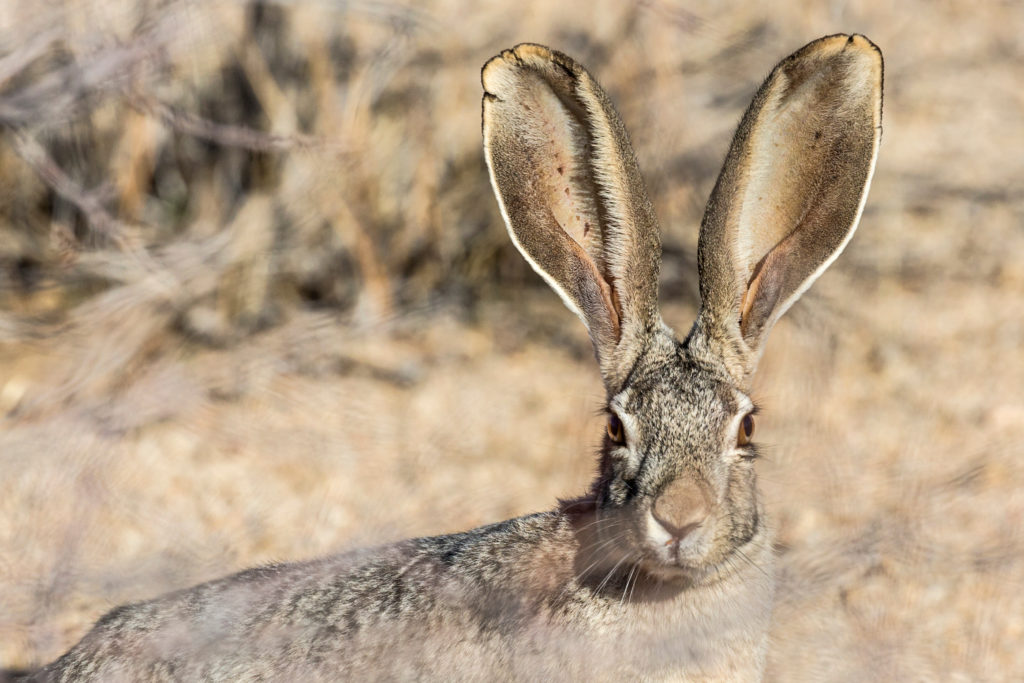
Because we stayed on the beaten paths and trails, we didn't get to see any bighorn sheep, bobcats or mountain lions. There have been several reports of mule deer and tortoises, but again, hiking on the well-populated trails, they avoided the crowds.
If you camp within Joshua Tree National Park itself, you'll be gifted by serenading coyotes who live in the distant outskirts of the park.
If you're a birder, the park will be one of your favorite sites for birdwatching. There are several southwestern desert species. Year round, you will likely see and hear roadrunners, mockingbirds, cactus and rock wrens, mourning doves, and phainopelas. You may also get a good viewing of the LeConte's thrasher and Gambel's quail.
Looking overhead, you might catch a glimpse of the American kestrel, Cooper's hawk, prairie falcon and the beautiful red-tailed hawk.
The winter birds you may see are: the common American robin, cedar waxwing, sage sparrow, white-crowned sparrow and dark-eyed junco. In March, they migrate while other bird species like orioles, bluebirds, flycatchers and thrashers arrive for spring and summer nesting.
3. Boulder and Rock Climbing
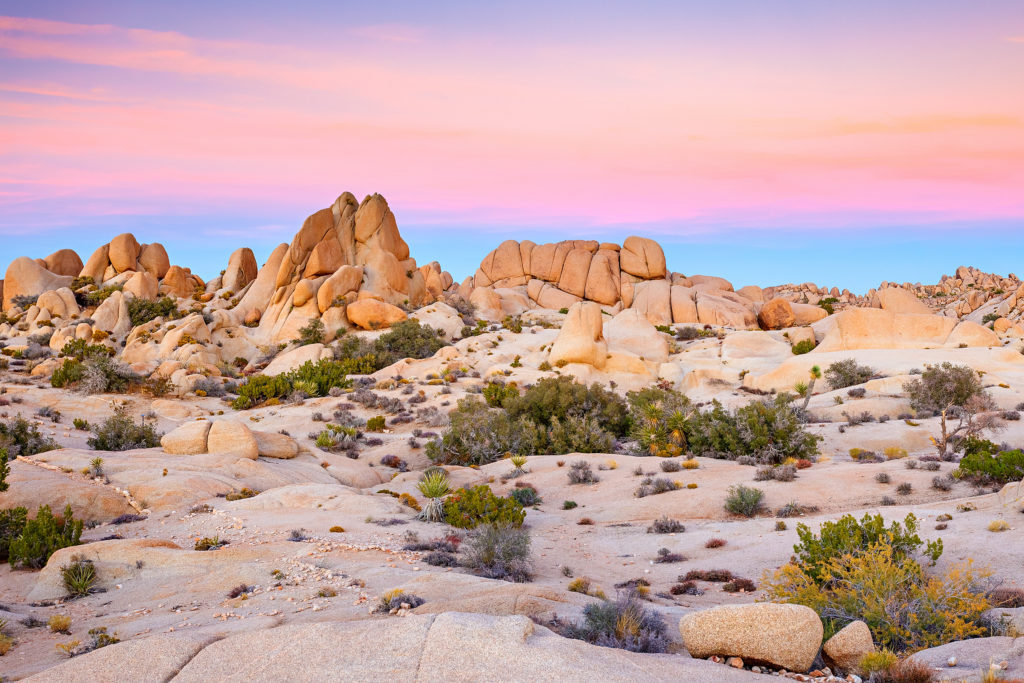
Joshua Tree National Park is a climber and rock scrambler's paradise. The park offers climbing challenges for all skill and ability levels. It has more than 8,000 climbing routes, 2,000 boulder problems, and hundreds of natural gaps to explore. If you're into playing on the boulders, make this your climbing destination.
However, before climbing to the higher levels, you'll need a permit. We recommend a climbing guide and taking a class if you're new or less experienced. Either way, make sure your rock guide is certified through the PCGI, AMGA, or a similar organization. Make sure they are also certified in wilderness first aid and CPR, and that they carry insurance. You can purchase a climbing guide or hiking map at park visitor centers. They are also available at outdoor shops in the surrounding communities of Joshua Tree National Park.
4. Hiking & Backpacking
Backpackers and hikers love Joshua Tree. Eighty-five percent of its 800,000 acres is managed wilderness. Because of the region's milder climate and temperatures, cool rock formations and desert life, it's no wonder that outdoor-minded people flock here. Make sure you acquire your permit before trekking off into the backcountry. And remember that it's a good idea to talk to the park rangers as they are there to provide assistance and keep everyone safe.
5. Camping
There's nothing more fun than camping at national parks, and Joshua Tree is no exception. There is camping available inside the park and in surrounding areas. Because of the length of our Landmark fifth wheel and our yearning to boondock, we chose to stay right outside the park's south entrance on Bureau of Land Management land.
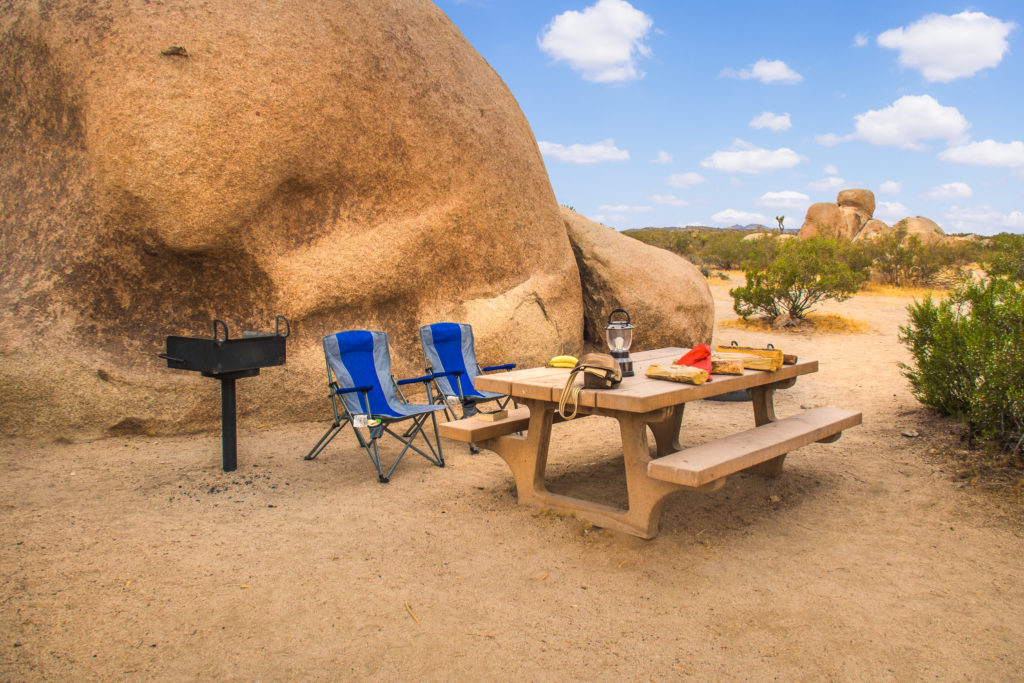
But if your RV is under 25 feet, there are campground options within the park. We recommend doing your own research before making reservations or plans.
Campgrounds that require reservations:
- Black Rock: This 100 site campground is located in the northwest corner of the park. It also has equestrian sites available.
- Cottonwood: Has 62 sites, portable water and flush toilets. The campground is near the Cottonwood Visitor Center in the southeast part of the park.
- Indian Cove: Has 101 sites, including 13 group campsites. There are vault toilets but no water or electric hookups. Campers register at the ranger station located at the entrance to the Indian Cove area. (Water is available there.)
- Jumbo Rocks: Includes 124 individual/family sites and is centrally located. Offers great views of rock formations.
- Ryan: Ryan is centrally located in the park and is adjacent to the California Riding and Hiking Trail. It has 32 campsites, with four designated equestrian sites. There is no water or electric available at this location so come prepared.
Campgrounds that are first-come first-serve:
- Belle: Contains 18 sites and is situated at an elevation of 3,800 ft. This campground has pit toilets and no water or electric hookups. Belle is a great campground for viewing dark night skies.
- Hidden Valley: Has 44 sites, pit toilets and no water. This campground is located along Park Boulevard and is surrounded by large boulders and Joshua Trees.
- White Tank: Located in the northern end of the park nestled among immense granite boulders. RVs and trailers may not exceed a combined length of 25 feet. No water or electric hookups. This campground has excellent night sky viewing and is located near the darkest section of the park.
If you are looking to reserve ADA accessible campsites, please look into Jumbo Rocks Campground, site 122 and Black Rock Campground, site 61. If you're looking for wheelchair access, be advised that roads and campgrounds are not paved. Though most campsites are relatively flat, the terrain can be uneven and may be unsafe for wheelchair movement.
There are day-use picnic areas within the park as well.
Campgrounds usually fill up on weekends between October and May. During peak times, including holidays and between February and May, campgrounds are typically at capacity during the week as well. We recommend reserving a site in advance. You could also plan your visit during the park's off season, from June through September. However, know that during those times, campsites are first-come, first-serve with no reservations. Also, some sites close during the summer due to the desert heat.
Lastly, know that there are camping options outside the park as well. Like previously mentioned, there are also boondocking opportunities outside the south entrance (near I-10) and north entrance (near the town of Joshua Tree).
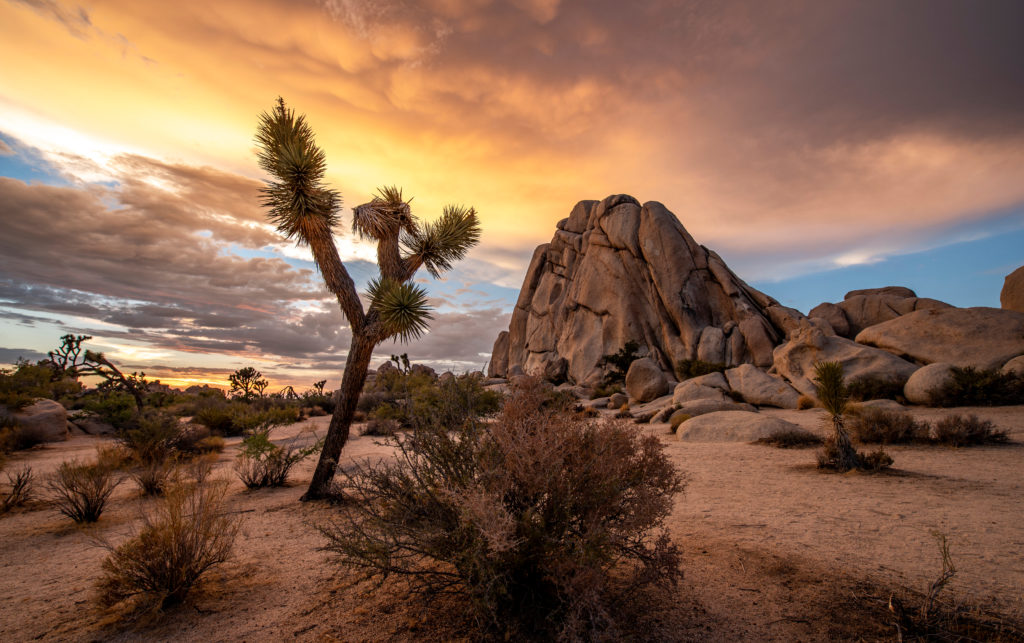
Photo: Shutterstock
5 more amazing things you can do within the Joshua Tree National Park boundaries are:
- Horseback Riding: There are over 253 miles of equestrian trails and corridors that traverse open lands, canyon bottoms, and dry washes throughout the park. The two most popular areas of the park for equestrian use are Black Rock Canyon and the areas near the West Entrance.
- King Ranch Tour: Listed as a National Historic Register Site, the property is located in a remote, rocky canyon in Joshua Tree National Park. To preserve its historic character, admission to the ranch is restricted to guided walking tours. The tours are a half-mile in length and last 90 minutes. You'll need to sign up for the tour with one of the rangers on duty.
- Geology Motor Tour: This 18-mile motor tour leads through one of Joshua Tree National Park's most intriguing landscapes. The tour takes about two hours round trip and includes 16 stops along a dirt road.
- 4-Wheel Backcountry Off-Roading: Mountain bikes and 4-wheel-drive registered and licensed vehicles are welcome in the park. Off-roaders must remain on the established roads for your own safety and to protect the natural features. Important note: OHVs and ATVs are not permitted in the park.
- Stargazing: On a clear, moonless night, stargazing inside the park is magical. With some of the darkest nights in Southern California, Joshua Tree National Park offers many visitors the chance to admire the Milky Way for the first time in their lives. Be aware, some areas of the park are darker than others based on the locale of nearby communities.
We hope this resource encourages you and your family to pack up your fifth wheel or travel trailer and head for Joshua Tree National Park. It will provide you and your family memories that will last a lifetime. And, if you're like us, you'll love it some much, you'll want to return for another visit.
This article was written by Dan & Lisa Brown of Always On Liberty.



